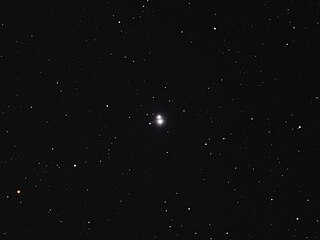The following lists of constellations are available:

A constellation is an area on the celestial sphere in which a group of visible stars forms a perceived outline or pattern, typically representing an animal, mythological person or creature, or an inanimate object.
In astronomy, stars have a variety of different stellar designations and names, including catalogue designations, current and historical proper names, and foreign language names.

Traditional Chinese astronomy has a system of dividing the celestial sphere into asterisms or constellations, known as "officials".
The Quadrantids (QUA) are a meteor shower that peaks in early January and whose radiant lies in the constellation Boötes. The zenithal hourly rate (ZHR) of this shower can be as high as that of two other reliably rich meteor showers, the Perseids in August and the Geminids in December, yet Quadrantid meteors are not seen as often as those of the two other showers because the time frame of the peak is exceedingly narrow, sometimes lasting only hours. Moreover, the meteors are quite faint, with mean apparent magnitudes between 3.0 and 6.0).
In contemporary astronomy, 88 constellations are recognized by the International Astronomical Union (IAU). Each constellation is a region of the sky, bordered by arcs of right ascension and declination. Together they cover the entire celestial sphere, with their boundaries adopted officially by the International Astronomical Union in 1928 and published in 1930.

This is a list of lists, grouped by type of astronomical object.
All stars but one can be associated with an IAU constellation. IAU constellations are areas of the sky. Although there are only 88 IAU constellations, the sky is actually divided into 89 irregularly shaped boxes as the constellation Serpens is split into two separate sections, Serpens Caput to the west and Serpens Cauda to the east.

Delta Herculis is a multiple star system in the constellation of Hercules. Its light produces to us apparent magnitude 3.12, as such the third-brightest star in the large, fairly dim constellation. Based on parallax measurement taken during the Hipparcos mission, it is approximately 23.1 parsecs from the Sun.

Zeta Sagittarii is a triple star system and the third-brightest star in the constellation of Sagittarius. Based upon parallax measurements, it is about 88 light-years from the Sun.

G Scorpii, also named Fuyue, is a giant star in the constellation of Scorpius. It has an apparent magnitude of +3.19. It is approximately 126 light-years from the Sun.

Eta Boötis is a binary star in the constellation of Boötes. Based on parallax measurements obtained during the Hipparcos mission, it is approximately 37 light-years distant from the Sun. Since 1943, the spectrum of this star has served as one of the stable anchor points by which other stars are classified. It forms a double star with the star BD+19 2726.

Delta Cassiopeiae is an eclipsing binary star system in the northern circumpolar constellation of Cassiopeia. Based on parallax measurements taken during the Hipparcos mission, it is approximately 99.4 light-years from the Earth.

Psi¹ Draconis, also designated 31 Draconis, is a triple star system in the northern constellation of Draco. The system is fairly close, and is located about 75 light-years from the Sun, based on its parallax.

Zeta Cassiopeiae, Latinized from ζ Cassiopeiae, and officially named Fulu, is a variable star in the constellation of Cassiopeia. It has a blue-white hue and is classified as a B-type subgiant with an apparent magnitude of +3.66. Based upon parallax measurements, it is approximately 590 light-years from the Sun.

Pollux b, also designated β Geminorum b and HD 62509 b, formally named Thestias, is an extrasolar planet approximately 34 light-years away in the constellation of Gemini. This planet was discovered orbiting the star Pollux in 2006 by astronomer Artie P. Hatzes, confirming his hypothesis originally published in 1993. The planet has at least twice the mass of Jupiter. It moves around Pollux in 1.61 years at a distance of 1.64 AU in a nearly circular orbit.
Some astronomical objects have proper names, often in addition to catalogue numbers or other systematic designations. This trivially includes the naked-eye planets as well as the Sun and Moon. A small number of stars have proper names in pre-modern astronomical tradition, but most naked-eye stars are identified by their Bayer or Flamsteed designations.
The name of the IAU constellation Scorpius in modern Chinese is 天蝎座.